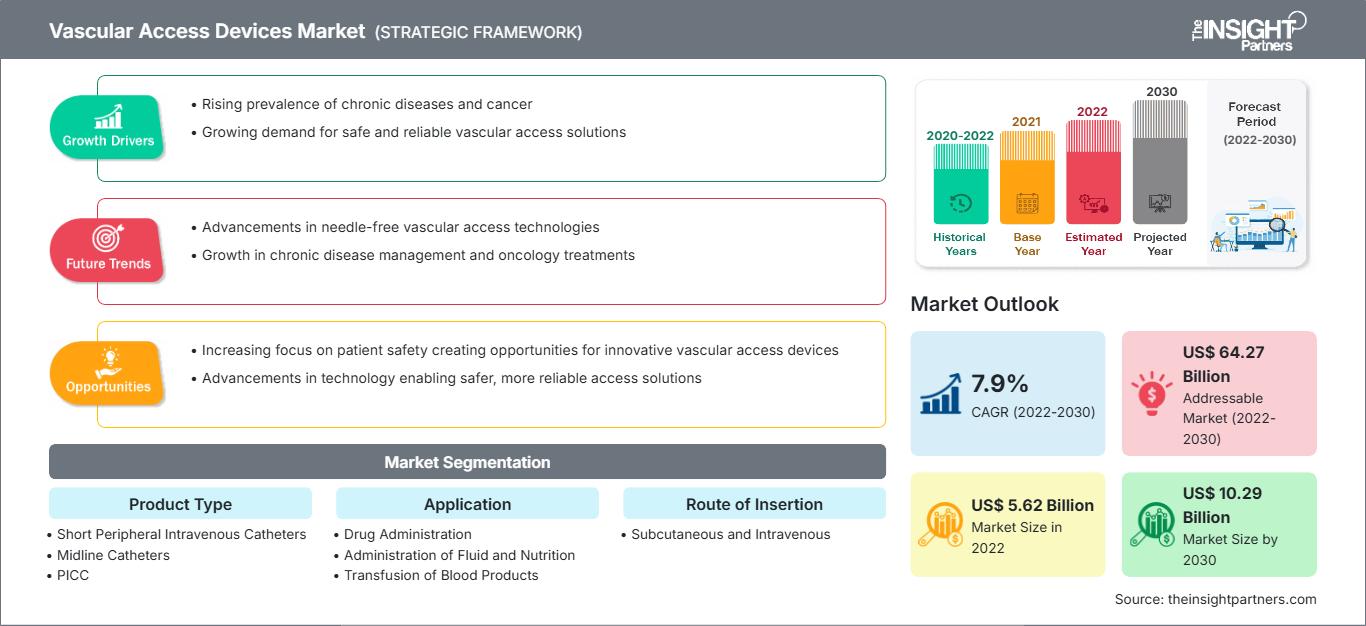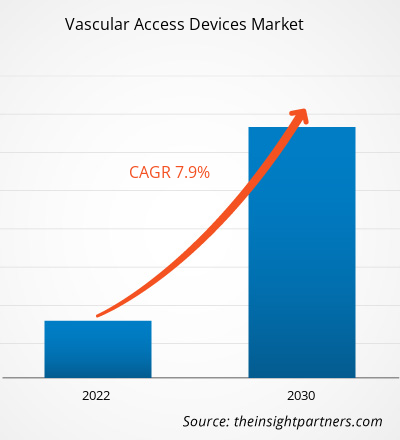[調査レポート] 血管アクセスデバイス市場は2022年に56億2,000万米ドルと評価され、2030年には102億9,000万米ドルに達すると予測されています。2022年から2030年にかけて7.9%のCAGR(年平均成長率)を記録すると予想されています。
市場分析とアナリストの見解:
血管アクセスデバイスは、上大静脈または下大静脈(内頸静脈、鎖骨下静脈、外頸静脈、大腿静脈)にアクセスするために、さまざまな解剖学的部位に留置されます。血管アクセスデバイス市場の拡大は、慢性疾患の有病率の上昇と化学療法の必要性の高まりによって牽引されています。さらに、市場での競争力を維持するための企業による戦略的取り組みも、市場の成長を後押ししています。 AI対応ロボット静脈アクセスデバイスの利用が大幅に増加することで、予測期間中に血管アクセスデバイス市場に新たなトレンドがもたらされる可能性があります。
成長ドライバーと課題:
化学療法は、強力な薬剤の投与により腫瘍を縮小または除去するために用いられる一次治療または補助療法です。そのため、がん症例の増加は化学療法の需要を高めています。国際がん研究機関(IARC)の推計によると、2020年には世界で1,930万人の新規がん症例が報告され、約1,000万人ががんにより死亡しました。南アフリカ国立がん登録局(NCR)によると、2020年には南アフリカで約11万人が新たにがんと診断され、5万6千人以上ががん関連で死亡しました。さらに、今後数十年間で疾病負担は増加すると予測されており、2030年には新規がん症例が13万8千人、2040年には17万5千人に増加すると推定されています。また、がん関連死亡率は両年でそれぞれ7万3千人、9万4千人に増加すると予想されています。このように、がん罹患率の上昇は血管アクセスデバイス市場の成長を牽引する要因となっています。
要件に合わせてレポートをカスタマイズ
レポートの一部、国レベルの分析、Excelデータパックなどを含め、スタートアップ&大学向けに特別オファーや割引もご利用いただけます(無償)
血管アクセスデバイス市場: 戦略的洞察

- このレポートの主要な市場動向を入手してください。この無料サンプルには、市場動向から見積もりや予測に至るまでのデータ分析が含まれます。
レポートの一部、国レベルの分析、Excelデータパックなどを含め、スタートアップ&大学向けに特別オファーや割引もご利用いただけます(無償)
血管アクセスデバイス市場: 戦略的洞察

- このレポートの主要な市場動向を入手してください。この無料サンプルには、市場動向から見積もりや予測に至るまでのデータ分析が含まれます。
レポートのセグメンテーションと範囲:
血管アクセスデバイス市場分析は、製品タイプ、用途、挿入経路、エンドユーザー、および地域という以下のセグメントを考慮して実施されています。製品タイプ別に、市場は短い末梢静脈カテーテル、ミッドラインカテーテル、PICC(末梢挿入型中心静脈カテーテル)、中心静脈カテーテル、埋め込み型ポート、および付属品に分類されています。中心静脈カテーテルセグメントの市場は、CICC(中心挿入型中心静脈カテーテル)、FICC(大腿挿入型中心静脈カテーテル)などにさらに細分化されています。用途に基づいて、血管アクセスデバイス市場は、薬物投与、体液および栄養投与、血液製剤の輸血などに細分化されています。挿入経路に基づいて、市場は皮下と静脈に二分されています。エンドユーザーに基づいて、市場は病院と診療所、外来手術センターなどに細分化されています。血管アクセス デバイス市場レポートの範囲には、北米 (米国、カナダ、メキシコ)、欧州 (スペイン、英国、ドイツ、フランス、イタリア、その他欧州)、アジア太平洋 (韓国、中国、日本、インド、オーストラリア、その他アジア太平洋)、中東およびアフリカ (南アフリカ、サウジアラビア、UAE、その他中東およびアフリカ)、南米および中米 (ブラジル、アルゼンチン、その他南米および中米) が含まれます。
セグメント分析:
血管アクセス デバイス市場は、製品タイプ別に、短い末梢静脈カテーテル、ミッドライン カテーテル、PICC (末梢挿入型中心静脈カテーテル)、中心静脈カテーテル、埋め込み型ポート、アクセサリに分類されています。中心静脈カテーテル セグメントの市場は、CICC (中心挿入型中心静脈カテーテル)、FICC (大腿部挿入型中心静脈カテーテル)、その他に細分化されています。 2022年には、短い末梢静脈カテーテルセグメントが血管アクセスデバイス市場で最大のシェアを占め、同じセグメントが2022~2030年に最高のCAGRを記録すると予想されています。
アプリケーションに基づいて、血管アクセスデバイス市場は、薬物投与、体液および栄養投与、血液製剤の輸血、およびその他のセグメントに分割されています。2022年には、薬物投与セグメントが最大のシェアを占め、2022~2030年に最高のCAGRを記録すると予測されています。
挿入経路に基づいて、血管アクセスデバイス市場は皮下と静脈内に分かれています。静脈セグメントは2022年に大きな市場シェアを占め、2022~2030年の間に高いCAGRを記録すると予想されています。
エンドユーザー別に、市場は病院と診療所、外来手術センター、およびその他のセグメントに分割されています。病院および診療所セグメント向けの血管アクセスデバイス市場は、2022年から2030年にかけて成長する可能性が高いです。
地域分析:
北米は、世界の血管アクセスデバイス市場の成長に最も大きく貢献しています。アジア太平洋地域は、2022年から2030年にかけて市場で最も高いCAGRを記録すると予測されています。慢性疾患の蔓延、高齢者人口の増加、新製品および既存製品の開発に携わる主要な市場プレーヤーの存在、技術進歩の高まりにより、北米は2022年に世界市場で最大のシェアを占めました。北米では、米国が2022年に最大の市場シェアを占めました。
血管アクセスデバイス血管アクセスデバイス市場の地域別分析
The Insight Partnersのアナリストは、予測期間を通じて血管アクセスデバイス市場に影響を与える地域的な動向と要因を詳細に解説しています。このセクションでは、北米、ヨーロッパ、アジア太平洋、中東・アフリカ、中南米における血管アクセスデバイス市場のセグメントと地域についても解説しています。
血管アクセスデバイス市場レポートの範囲
| レポート属性 | 詳細 |
|---|---|
| の市場規模 2022 | US$ 5.62 Billion |
| 市場規模別 2030 | US$ 10.29 Billion |
| 世界的なCAGR (2022 - 2030) | 7.9% |
| 過去データ | 2020-2022 |
| 予測期間 | 2022-2030 |
| 対象セグメント |
By 製品タイプ
|
| 対象地域と国 | 北米
|
| 市場リーダーと主要企業の概要 |
|
血管アクセスデバイス市場のプレーヤー密度:ビジネスダイナミクスへの影響を理解する
血管アクセスデバイス市場は、消費者の嗜好の変化、技術の進歩、製品の利点に対する認知度の高まりといった要因によるエンドユーザーの需要増加に牽引され、急速に成長しています。需要の増加に伴い、企業は製品ラインナップの拡充、消費者ニーズへの対応のためのイノベーション、そして新たなトレンドの活用を進めており、これが市場の成長をさらに加速させています。

- 入手 血管アクセスデバイス市場 主要プレーヤーの概要
業界の発展と将来の機会:
血管アクセスデバイス市場の予測は、主要企業の出版物、協会データ、データベースなど、様々な二次および一次調査結果に基づいて推定されています。主要な市場プレーヤーが発表したプレスリリースによると、いくつかの戦略は以下のとおりです。
- 2023年11月、BD(ベクトン・ディッキンソン・アンド・カンパニー)は、一体型カテーテルと互換性のある新しい無針採血技術を発売しました。これは、同社のビジョンである「ワンスティック入院」の実現に貢献します。 PIVO Proニードルフリー採血デバイスは、NearPort IVアクセスを備えた新しいNexiva閉鎖型IVカテーテルシステムを含む、一体型および長尺末梢IVカテーテルとの互換性を実現するために設計が改良されています。
- 2023年5月、Teleflex Inc.は、PICC挿入手順を向上させ、合併症のリスクを低減するために設計された2つの新デバイス、Arrow VPS Rhythm DLXデバイスとNaviCurve Styletを発売しました。VPS Rhythm DLXデバイスは、患者の心臓の電気活動を用いてカテーテル先端の位置情報をリアルタイムで提供します。 NaviCurve スタイレットは、患者の解剖学的曲線と柔軟な先端部を備えており、PICC を上大静脈(SVC)に挿入しやすく、挿入を成功させるために患者の解剖学的構造に合わせて自動的に位置調整するように設計されています。
競合状況と主要企業:
Teleflex Inc、BD、B. Braun SE、Terumo Medical Corporation、Medtronic、Fresenius Kabi、Baxter、Vygon SAS、Kimal、Access Vascular Inc は、血管アクセスデバイス市場レポートで紹介されている主要企業です。さらに、市場とそのエコシステムの全体像を把握するために、本調査では他の複数の企業についても調査・分析されています。これらの企業は、世界中の消費者からの高まる需要に応え、専門分野における製品ラインナップを拡大するため、地理的拡大と新製品の発売に注力しています。グローバル展開により、大規模な顧客基盤へのサービス提供が可能になり、ひいては市場拡大を促進しています。
- 過去2年間の分析、基準年、CAGRによる予測(7年間)
- PEST分析とSWOT分析
- 市場規模価値/数量 - 世界、地域、国
- 業界と競争環境
- Excel データセット
最新レポート
お客様の声
購入理由
- 情報に基づいた意思決定
- 市場動向の理解
- 競合分析
- 顧客インサイト
- 市場予測
- リスク軽減
- 戦略計画
- 投資の正当性
- 新興市場の特定
- マーケティング戦略の強化
- 業務効率の向上
- 規制動向への対応




















 無料サンプルを入手 - 血管アクセスデバイス市場
無料サンプルを入手 - 血管アクセスデバイス市場